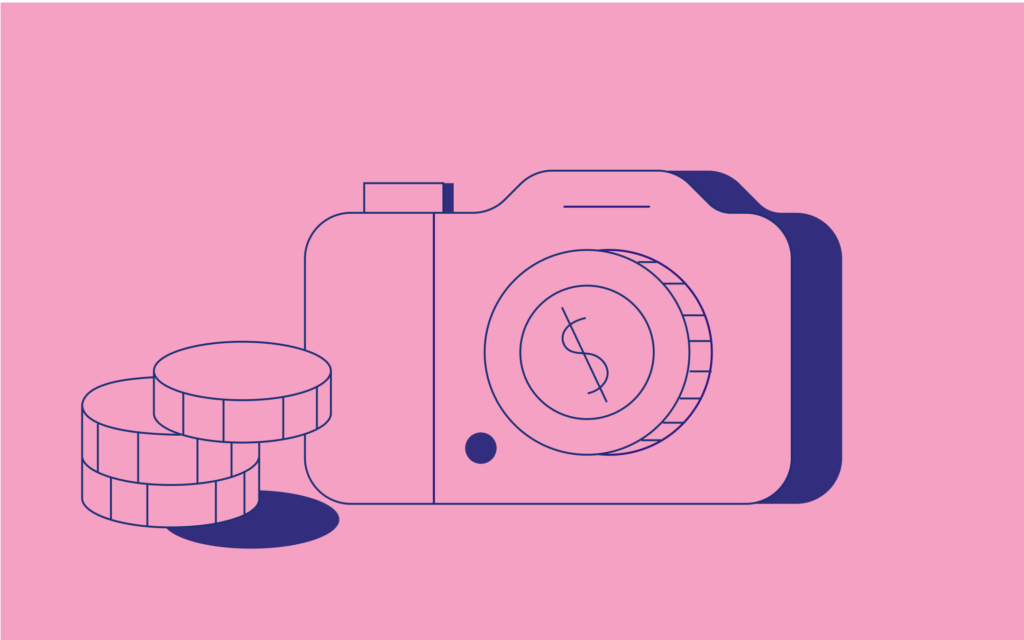Why Do Billion-Dollar Companies Use Stock Photography?
Why Do Billion-Dollar Companies Use Stock Photography?

The following pictures are from the websites of Fortune 100 tech companies in the year 2019. I did not edit or manipulate them in any way, and most of them are only one click away from the landing page. To reiterate, these are companies that drive billions of dollars in revenue, and often spend years crafting their identity.

Three business professionals inexplicably working on one computer, eleven people smiling into the same void, a hand with the power to emit data-point holograms – this is the visual language of stock photography for enterprises.
When it comes to the subject matter, there is a myriad of topics, but as Megan Garber of The Atlantic wrote in 2012, “One of the most wacky, wondrous elements of stock photos is the manner in which, as a genre, they’ve developed a unifying editorial sensibility. To see a stock image is … to know you’re seeing a stock image.”
The benefits of using stock are obvious: cheap, easy to implement, mostly inoffensive, time-saving. But why do so many lucrative companies with the time, resources, and money needed to produce authentic visual assets use stock? Either it doesn’t matter, or companies don’t understand how much it’s hurting them.
Stock Wastes Real Estate
According to an eye-tracking study by Nielsen Norman Group, people gloss over or entirely ignore generic or stock images. Every stock image is like a blank lot on the most valuable strip of real estate your brand has: your website. Regardless if stock isn’t detrimental to your brand, at the very least, it’s invisible. And in a crowded marketplace, whatever isn’t actively working to create meaningful differentiation is hurting you in the long run.
Stock Hurts Your Employer Brand
While there has been an effort in recent years to diversify representation in stock, it’s still a field that is predominately white and male. It may be unconscious, but when you lead with photography that doesn’t allow for other viewpoints to exist, you’re shutting yourself off to future talent.
Seventy percent of women don’t feel represented in media and advertising, and those who purchase stock photography are on the hunt for more inclusive and diverse images. Getty reports huge increases in the following terms over the past year: “real people” 192% increase, “diverse women” 168% increase, and “strong women” 187% increase. With authentic creative, you pull in talent because they see your real team, rather than a computer-generated idea of “teamwork.”

In a great post over at Intechnic, they compare the difference between real and staged photos. One of these women is a real Project Manager, the other woman is from a generic stock photo featured on countless websites. Can you tell which one is which?
It seems small, but the net result of using authentic visual language adds up over time. All of it works toward making your brand identity more approachable and tangible. People will feel more comfortable contacting you, inquiring about a job opening, trusting your products, doing business. As they say over at allBusiness, “There’s nothing more inauthentic than a professionally staged photograph of people who clearly don’t work at the company. It puts your company behind an overly polished veneer that makes you seem distant and possibly uninviting.”
Stock Sacrifices Your Vision and Brand Affinity

Images have a language of their own. For instance, this image tells me, “We need more computers at the office.” When it comes to your brand, your product, your vision of the future, why would you want to lead with someone else’s words? Even if you spend hours burrowing deep into the wormhole of royalty-free images, you’ll always end up making a concession on the integrity of the brand. As writer Grant Epstein says, “Imagine if a print ad for Coca-Cola used a generic image of people holding cups of unidentified brown liquid. It would be so bizarrely off-brand that you wouldn’t even identify it with the company at all.”
A Revolution Is Coming for B2B Design
For the record, there’s nothing inherently evil about stock photography. But for me, it speaks to a larger trend that I don’t quite understand. Why are so many companies, especially those in the B2B tech sector, comfortable with poor design? Why is there such a mental division between our expectations of what B2C and B2B should look, feel, and sound like?
As Ross Simmonds writes in his post, “Why Are Most B2B Websites Designed So Poorly Even in 2019?” from usability challenges to inconsistent visual assets, there’s no shortage of aesthetic issues in the field. Traditionally, B2B companies have complex sales cycles and logistics to convey. Trying to explain CRM, ERP, or inventory management software is obviously more aesthetically challenging than featuring a gorgeous consumer product. Still, that doesn’t mean people are willing to accept poor design, repetitive visuals, or a lack of differentiation. It doesn’t matter how good your product is: nothing sells itself.
“As the average age of B2B buyers drops, their expectations for the online experience rise,” writes Simmonds. “These buyers are expecting a buying experience that resembles something they’d find visiting Amazon, eBay, Etsy or their other favorite online retailer. The best website experiences are created from a place of empathy and a keen understanding of the goals a buyer has when they visit your site.”
As with any challenge, there is also a massive opportunity here for B2B companies that are willing to lead with something bold, emotive, and design-forward. Don’t package your brilliant product in bad creative.
Emotive Brand is a brand strategy and design agency in Oakland, California.






